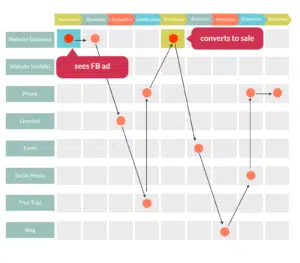In today’s world, it has become imperative for businesses to focus on the enhancement of customer experience. A business who offers better customer experience gains a competitive advantage over its rivals and tends to grow more rapidly. Customer journey analysis is an important factor in realising enhanced customer experience. Consequently, it is important for businesses to know how they can map the journey of a customer so that important information can be deduced from it.
There are certain steps that businesses can follow in order to create customer journey maps that are elaborated as below:
- Find the Starting Point
The first step in the customer journey mapping is to find the initial points from where the whole process will commence. As the journey map is related to the customers, it is important to analyse the actions, behaviours, and needs of the customers. Without observing customers, laying down the foundation of the journey mapping is almost impossible. Moreover, if it’s the first time of business, the step becomes even more challenging.
For businesses that already have some sort of customer data, they have the advantage of already knowing their customers’ response to their product or service. However, the business that has nothing beforehand will have to initiate the mapping process with mere intuition and guesswork. Irrespective of the way that businesses choose, they will have to perform activities including making changes, revising, etc, to their customer journey maps. As the business will get the opportunity of learning something new about its customers, it will have to make changes to the map to make it more effective.
- Define the Stages of Map
After knowing where to start, the next step is to recognize the different stages of the customer journey map. Usually, the stages of the map get its inspiration from the experiences that customers tend to have while interacting with a business. For instance, the first stage represents how the customer becomes aware of the brand. The other levels that customers may come across are namely, research, evaluation, justification, purchase, adoption, retention, expansion and advocacy. It is important to review these stages because it will give an idea of how customers are reacting at a certain stage. It will also give an idea of how to retain the customers and how customer churn can be minimised.
For the next steps, we will consider taking the example of ABC Company, which is a marketing automation service provider, for a better understanding of the journey mapping process.
- Discover Customer Touchpoints
Touchpoints are the different ways that customers use to interact with the business. Pertaining to the journey map, the touchpoints will be plotted at the y-axis. Coming to the ABC company, let us consider that their website is mobile-friendly and have features like live chat, phone, email service as sale channels. Additionally, the company offers support and marketing services over social media and has a blog that acts as a platform for directing new customers and retaining old ones.
- Create and Place Personas On the Journey Map
In order to make the journey map useful and have practical value, it must have the ability to map the actions of actual customers. In fact, this will help to monitor the progress of specific customer segments. Usually, the actual segment of the customer base is represented by personas.
The personas itself are somewhat imaginary and represents a specific customer segment of a business. Both quantitative and qualitative data is utilised to carefully create personas and requires serious efforts. There are certain questions that can help in the conception of personas such as who are the existing customers of the business, who the business wants to attract as leads, what are their motives with regard to the product of the business, what are the challenges that prospects are facing, what are their pain points, and what are their skills. By getting answers to these questions, businesses can create personas for their journey maps.
You can find many, many versions of a customer journey map out there. Google Journey map templates and you will see the various different templates. Here is a good simple example below or you could also find one from our website here.
After the creation process completes, it’s time to position the personas on the map. For illustrating this step, consider that the ABC Company has created a persona for one of its customers named as Paige who is a CMO of a startup. Being the only person in the marketing team of her organization, it’s her though to automate some marketing tasks until her team grows.
Paige found the ABC Company while on Google and explored how the company can help her regarding the marketing strategy. While researching, she has some questions related to the lead generation and for getting the answers, she contacted the customer representative of the ‘ABC Company’ by making the use of the live chat feature. The representative provided all the answers to the queries of Paige and offered her a free trial for testing the company’s product.
When the free trial period of the Paige came to an end, the representative contacted her and she opted for their services by becoming a paying customer. Afterward, Paige is contacted using email and phone and informed about how to master the product. By using the promotional emails and blog, the ABC Company regularly updated Paige about their new products and added features. After some time, Paige accumulated a talented team of marketers and the ABC Company asked her to narrate her success story that will get featured of the company’s website. In this way, the complete customer journey of the Paige is mapped out.
- Identifying Pain Points
While mapping the journey of customers, it is important for the business to get a clear insight into its strengths and weaknesses. Points that tend to frustrate and causes a customer churn should be noted.
For instance, Paige founded the ABC Company through Google search but the company wasn’t the first one that she viewed. It happened because the Google ranking of the ABC Company is not that good. Consequently, they need to improve their rankings on the basis of the search keyword, which was marketing automation tools in case of Paige. Moreover, the company founded that its strategy to assign a particular representative to every new user for guiding and walking through the product is highly successful.
- Incorporating KPIs
For a customer journey map to be effective it is important to ensure that it is formulated using analytical and factual data. Monitoring the customer behavior regarding the product, how they reach the business, what channels they prefer, etc, all these things need to be considered. There are numerous tools and techniques that businesses can utilize to get all the necessary information that they need to map the journeys of the customers. The main agenda of the journey maps is to justify the behavior of customers.
Involving the Teams and Delegating Tasks
As soon as the customer journey map is drafted, the next task for the business is to analyze it and identify the areas that need improvement. For instance, a recent research study revealed that 3-4 percent of revenue can be increased simply by allocating a mere 1 percent of the total sales budget to the product design and development. Thus, involving the whole team of the business to analyze customer journeys is important to extract useful ideas.
Challenges That Businesses Come Across While Mapping Customer Journeys
Every business is quite aware of the fact that mapping the journeys of customers is a task that requires strenuous efforts. Moreover, there are many pitfalls within the process that can result in all the efforts of a business to go in vain. Nonetheless, the following are some common challenges that most businesses undertaking journey mapping have to face and conquer in order to become successful:
- Distinct Needs
Every company that is working even in a single industry is different from others in a certain way. This results in every company to have their own personalized customer journey maps. Just as two companies can’t be similar so does the journey maps. Therefore, every company needs to put in efforts to go through the process of journey mapping so that they will be able to enhance the experience of their customers.
- Overloading Map With Personas
One common problem that businesses face is that they are unaware of what number of personas will be good for their journey maps. Consequently, they burden their maps with a large number of personas that complicates everything later on. Moreover, some businesses did this intentionally with the hope that more personas will let them draft more powerful customer journey maps. Sadly, it is not true and instead, such business ruins their whole efforts. By introducing a large number of personas, a business will, become unable to identify the true motivations of actual customers, fail to work in coordination with the goals that were set at the start.
- Ignoring External Factors
It is important for businesses to realize that the customer journey exists in a dynamic environment where external factors can affect the behavior of customers. Ignoring external factors while preparing the journey maps might result in getting unexpected results.
- Rigidity
As businesses grow over time, their customer base expands and the way a customer enters the journey map will fluctuate widely. Many businesses fail to employ flexibility in their journey mapping and a result, it becomes difficult to create effective maps. Thus, it is important to ensure that the journey map of the business is flexible and can adapt to changes. One possible way to do so is to implement a customer feedback loop, which ensures that a business stays up to date with its customer base and introduce all the required changes in the map at the earliest.
Wouldn’t it be good if you had the clarity of the marketing touch points your customer has with your brand? Try out this template and make it possible.




